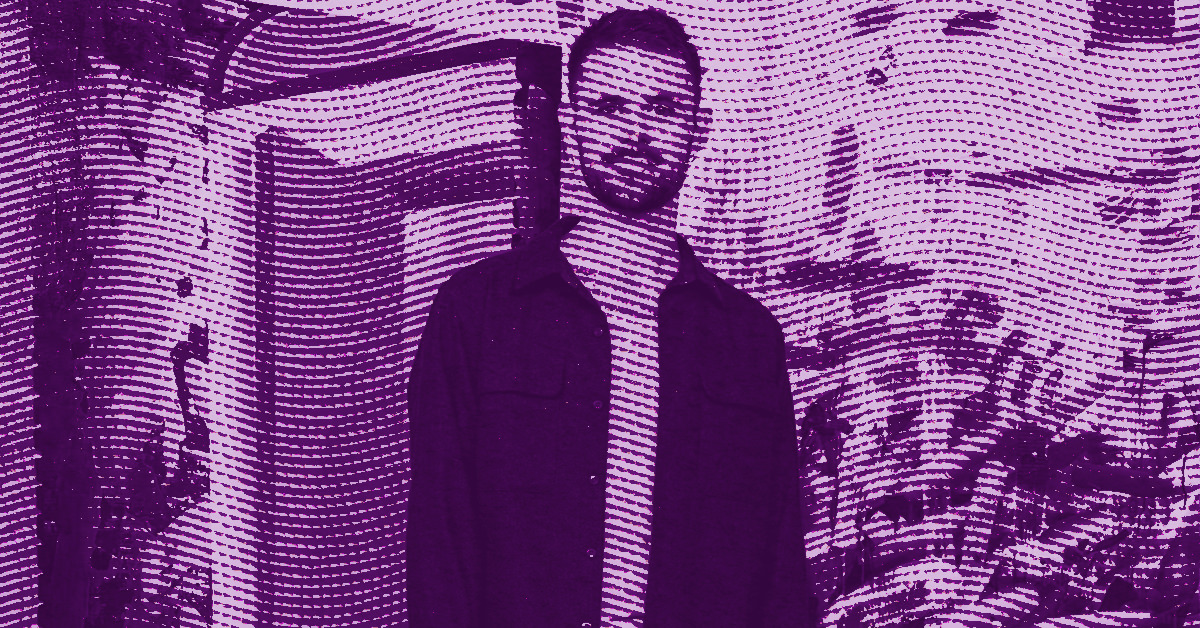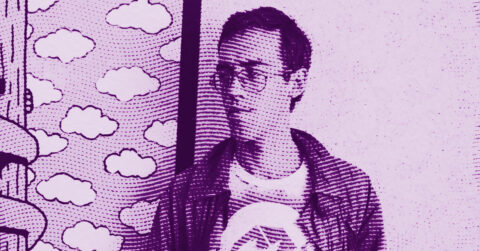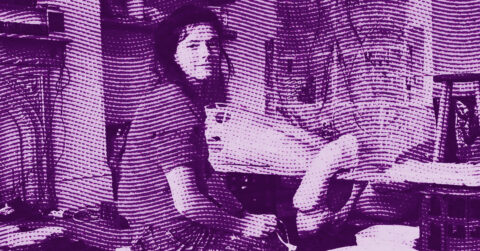Listen to me carefully, you bunch of snobs: Kyle Dunn paints naked men in apartments, and you would do well to pay attention. Not because male nudity still constitutes a provocation in 2025, we passed that stage long ago, but because this Brooklyn-based American artist accomplishes the paradoxical feat of rendering theatrical intimacy, cinematic everyday life, and solitude strangely inhabited. In his acrylic paintings on wood panels, usually measuring between 1 and 2 meters high, Dunn constructs domestic scenes where light slices the space with the precision of a scalpel, where every object, a balancing coin, a squashed fruit, or a satin ribbon, carries the weight of a symbol that one senses but cannot fully decipher.
The cinematic genealogy of his work is not a mere influence but a true structural lineage. Dunn himself states outright: “Almodóvar is my all-time favorite artist” [1], thereby establishing a direct line to the Spanish director and, through him, to Douglas Sirk, the German master of 1950s Hollywood melodrama. This ancestry deserves careful attention as it forms the keystone for fully understanding his work. In Sirk’s films, saturated colors and rigorous compositions served to expose the hypocrisy of postwar American society, transforming domestic melodrama into devastating social critique. Bourgeois interiors became gilded cages where characters suffocated under the weight of conventions. Almodóvar inherited this aesthetic but turned it inside out, using the same visual vocabulary to celebrate rather than denounce, to embrace excess rather than criticize it.
Dunn achieves a remarkable synthesis of these two approaches. His paintings borrow from Sirk that ruthless architecture of light, those sharp divisions between lit areas and cast shadows that carve the space into distinct psychological territories. “In films, cinematic light effects often create brutal color fields interacting with defined light zones. Similarly, I often structure my paintings around these divisions between light and darkness” [1], he explains. This light is never naturalistic; it always comes from a source one senses as artificial, like on a film set. In The Hunt (2022), a major work exhibited at the Wadsworth Atheneum, a young man perched on a dresser adopts an improbable pose, one white boot on a foot, the other foot clad in a simple sock. The nocturnal light carves the open drawers into jagged shapes, creating this rhythmic pattern that served as the starting point for the composition. But unlike Douglas Sirk’s pessimism, there is an underlying tenderness in Dunn’s work, a humor that defuses what could become tragic. The dog emerging from the frame, the reproduction of a Bruegel painting leaning against the furniture, the phone casting its pale glow on the wall, these are elements that introduce a narrative dimension without ever resolving it.
This narrative ambiguity precisely constitutes Almodóvar’s most pervasive legacy. In the work of the Spanish director, stories systematically refuse to be confined to a single interpretation. Drama coexists with farce, eroticism borders on ridicule, and this semantic instability becomes a source of freedom rather than confusion. Dunn reproduces this strategy in painting with consummate skill. His compositions are filled with what he himself calls “Easter eggs” [1], these visual clues that suggest multiple meanings without ever imposing just one. In Studio Still Life (2024), the still life in the foreground, lush fruits, kitchen utensils, and workshop equipment, unfolds a catalog of erotic insinuations with an assumed humor. A pestle rests in an open mortar, a crushed pear oozes its nectar, a phallic amaryllis is about to bloom. But should we see this as a celebration of sensuality or a satire of our tendency to sexualize everyday life? Both readings coexist, and this coexistence is the very purpose of the work.
The artist actually works according to a method that strangely recalls the cinematic production process. He begins with photographs taken on a mobile phone, generally captured to seize “a brief moment of light, the light falls in a room in a certain way” [1]. These images are then digitally combined, in a process he compares to collage, creating digital sketches that will serve as the basis for the paintings. This synthetic approach, where reality is constantly recomposed, edited, artificially lit, transforms each canvas into a film set, a reconstructed stage. The male figures inhabiting these spaces, often his fiancé, sometimes himself, always a composite, become actors playing their own roles in an undetermined scenario. “I work half autobiographically and half fictionally” [1], Dunn specifies, summarizing in a concise phrase this indecisive zone between document and fiction that characterizes both Almodóvar’s cinema and his own pictorial practice.
Melodrama necessarily involves exaggeration, the amplification of emotions up to the grotesque, and it is here that Dunn reveals all his sophistication. His paintings never fall into sentimentality precisely because they display their artificiality. The smooth, hairless bodies of his characters resemble mannequins; the poses, often inspired by old masters, are too composed to be natural; the light, as we said, is ostentatiously theatrical. This ironic distance preserves the work from pathos while allowing the exploration of intense emotional states. In Paper Angel (2023), a naked crouching man contemplates a heterogeneous assemblage of objects, books, eggs, paper rolls, citrus fruits, and cigarettes. The scene could slip into misery, but the geometric rigor of the composition, the arabesque that links the figure’s bent back to the silhouette of a paper-cut angel on the wall, transforms the painting into as much a formal meditation as an emotional one. The dramatic chiaroscuro certainly evokes solitude, but with an almost operatic grandeur that transfigures the moment into an archetype.
Beyond this cinematic lineage, Dunn’s work is part of a specifically American pictorial tradition that must be carefully examined. Critic Christopher Alessandrini positions him as “the natural heir of mid-20th century American queer modernism: the carnivalesque density of Paul Cadmus; the everyday surrealism of George Tooker or Jared French; the mythological poses of George Platt Lynes” [2]. This genealogy is not trivial. These artists, active between the 1930s and 1970s, maintained a rigorous figurative practice at a time when abstract expressionism dominated the American art scene. Their commitment to the meticulous representation of the male body, their exploration of masculinity outside heteronormative codes, and their use of ancient techniques such as egg tempera testified to a conscious resistance to the modernist injunctions of their time.
Dunn inherits this paradoxical position: to be contemporary by looking to the past, to be radical by mastering academicism. His initial training in interdisciplinary sculpture at the Maryland Institute College of Art might seem anecdotal, but it actually explains a lot. Before fully dedicating himself to painting, Dunn created painted reliefs, working on panels of epoxy resin, plaster, and foam that he sculpted before painting. This hybrid approach between two and three dimensions persists in his current painting, even when executed on a flat surface. The objects seem to want to come out of the frame; the cast shadows acquire an almost tactile presence; the reflective surfaces multiply levels of reality. This sculptural sensibility brings him closer to the tradition of American trompe-l’oeil, notably the still lifes of John Frederick Peto, which the Wadsworth Atheneum holds in its collections and from which Dunn directly drew inspiration for his 2024 institutional exhibition.
Trompe-l’oeil is not a mere technical feat but a philosophical inquiry into the boundaries between illusion and reality, between surface and depth. In Peto’s still lifes, ribbons and pieces of paper appear to be fixed to the painting by tacks painted with such meticulousness that one would want to tear them off. This deliberate confusion of registers finds its equivalent in Dunn’s systematic use of mirrors, reflections, and transparent objects that blur spatial reading. In Sea Bell (2024), a young man lying on cobalt blue sheets is overflown by a leaping frog seemingly aiming for a moth. On the wall, the framed image of a heron holding a fish in its beak establishes a nested system of predation where it is no longer clear who is hunting whom, or even if this hunt is real or fantasized. Trompe-l’oeil here becomes a narrative device, a way to multiply interpretative possibilities.
This technical virtuosity serving a deliberate semantic ambiguity perhaps constitutes the most irritating and the most stimulating aspect of Dunn’s work. His paintings stubbornly refuse to deliver a clear message. Are they celebrations of contemporary queer domestic life or meditations on universal solitude? Do they document intimacy or stage it? Do they offer an escape to the viewer or compel them to confront their own position as a voyeur? The artist claims this openness: “The paintings, at best, are tools to make someone feel an emotion. If it makes you feel something, that is exactly what I’m looking for” [1]. But this apparent modesty masks a considerable ambition: to make each painting not a closed work in itself but a projection space where the viewer actively constructs their own experience.
The titles participate in this strategy of controlled openness. Devil in the Daytime (2024), the eponymous work of his first solo exhibition in Los Angeles, refers to the midday demon, that monastic acedia that burdens the monk in the middle of the workday. Dunn draws a parallel between this medieval spiritual agitation and the contemporary experience of productivity, this constant injunction to be creative which paradoxically leads to procrastination. The painting shows abandoned shopping bags, suggesting a disappearance or flight, but towards what? The title opens a field of cultural and philosophical resonances without ever resolving into a univocal explanation.
This conceptual sophistication, this ability to make apparently contradictory registers coexist, eroticism and humor, the everyday and the mythological, autobiography and fiction, places Dunn in a singular position within contemporary figurative painting. At thirty-five, with works already present in the collections of the Dallas Museum of Art, the Institute of Contemporary Art in Miami, the Wadsworth Atheneum, and the X Museum in Beijing, he has quickly gained institutional recognition that attests to the relevance of his project. But beyond these external validations, it is the internal coherence of his approach that impresses: every element, from the panel formats to the smooth texture of the acrylic, from the choice of subjects to the construction of the compositions, contributes to a unified vision where nothing is left to chance.
Yet, it would be reductive to see in this work only an exercise of formal virtuosity. The political stakes, although never proclaimed, are no less present. Representing naked men in vulnerable postures, showing queer domestic interiors with the same dignity that old masters accorded to biblical or mythological scenes, means operating a considerable symbolic shift. Dunn does not need to brandish slogans; his paintings quietly accomplish what decades of activism have made possible: the inscription of homosexual daily life in the grand narrative of Western art history. This apparent normalization, men doing yoga with their dog, dozing in the afternoon, contemplating their reflection, is actually an achievement, and the serenity with which Dunn treats these subjects testifies to a freedom hard-won by previous generations.
The question remains, however: in fifty years, what will be remembered about these paintings? Their technical perfection, which may appear cold to the eyes of those who prize gestural expressiveness? Their narrative content, which might seem anecdotal compared to the great pictorial epics of the past? Or precisely that unresolved tension between form and content, that ability to keep the viewer in a state of productive uncertainty? Art history is littered with technically accomplished painters who fell into oblivion because their virtuosity served no true purpose. Does Dunn run this risk? Probably not, because his formal intelligence is always at the service of an authentic unease, a sincere attempt to capture something elusive in contemporary human experience. His paintings are sensation traps, devices designed to crystallize fleeting emotional states. Whether they achieve this with grace rather than violence, with irony rather than pathos, may be their most precious uniqueness. In a world saturated with images that scream to attract attention, Dunn whispers, and that is precisely why we come closer, look more closely, and stay. Painting, this supposedly obsolete art, here regains its full power to suspend time, a freeze-frame where all the ambiguities of what we are are condensed. And if you are still not convinced, it is probably because you are looking for your emotions in the wrong place.
- Katie White, “There’s a Coyness: Inside Kyle Dunn’s Symbol-Rich Cinematic Interiors”, Artnet News, June 27, 2024.
- Christopher Alessandrini, “Kyle Dunn’s Paintings Portray Games of Anticipation”, Frieze, July 4, 2024.
















